Is Rory McIlroy a Choker?
February 18th, 2024.

The 2024 Genesis Invitational was entirely Tiger Woods’ event until it no longer was. Not only was his charity TGR Foundation the host charity of the event, literally no one else in the field matters as long as Tiger is present.
As Tiger fades into the sunset as he eventually must, who might be a worthy heir-apparent? Someone with personality, charisma, intelligence and, what modern fans love – phenomenal ball-striking with a well-matched rest-of-the-game? The only golfer that could possibly be the next Tiger in terms of exciting both fans and media is Rory McIlroy.

However, some work needs to be done for him to step into Tiger’s difficult-to-fill shoes. He has historically been referred to as a ‘choker’. It was a hotly debated topic in 2019 when he carded an eight-over-par 79 during his first round of The Open that year. Famous commentators Brandel Chamblee and Frank Nobilo were not only not impressed, but Chamblee went on to add that in his 18 previous majors too, Rory had had a far higher first round score than for the remaining three rounds in those events.
At the time Chamblee had said, “He consistently gets off to a bad start and then … when the pressure is gone, all that talent arises and then he plays a beautiful second or third or fourth round. When someone consistently performs under expectations, the word is choking.”
A better definition for ‘choking’ might be a more scientific one, because the word ‘expectations’ can be rather subjective. The American Psychological Association states, “In sport, choking under pressure is a negative athletic experience… researchers have labeled choking as any decrease in performance under pressure.”
Rory’s fellow Northern Irishman, Eamon Lynch, television host and journalist, appears to be a friend and fan of Rory’s. He did not consent to being interviewed on the topic of Rory, but when pressed about whether he thought Rory was a choker he said a very definitive ‘No’. Why then does Rory hit some brilliant shots and immediately after – not one day, one week or a few weeks after, but immediately after – hit some very deplorable ones? ‘That’s golf,” he said.
Two gentlemen who played the pro-am with Rory the day before the 2024 Genesis Invitational at the famed Riviera Country Club only had praise for Rory’s game. Abe Tucker and Dan Taylor were blown away. Taylor, “He is hitting the ball fabulously. On 17th he hit 295 yards with a 3-wood to about 15 ft. on the green.” “And made an easy birdie,” added Tucker. “His tee shots and irons are the best in golf.” Neither of the two fans, when declaring him to be a superior ball-striker, took into account the sliced drive on the 18th that travelled a long way but sliced a lot. It then required a low shot through the eucalyptus trees, and eventually resulted in a bogey. Such a shot, especially under non-pressure conditions is alarming. Never mind if it was a casual swing or that he might not have put adequate focus into the shot!
Did the two amateurs believe that Rory might be a choker? “No, not at all.” So why does he play some bad shots at some random stages during a round? “You know, that’s golf,” said one of them, unconsciously echoing Lynch, while the other, at the very same moment said, “That’s golf.”
A very articulate follower of professional golfers was able to better explain why he does not believe Rory chokes. Geoff Shackelford, golf journalist and golf course design consultant, is one of three golf journalists who have covered the event at the Riviera Country Club longer than anyone else. “Rory is a better player now that he was when he was winning majors. He was very one-dimensional about what kind of courses he could play on.

“Modern equipment, launch monitors, fitness, instruction and even the condition of the golf courses has brought all Tour players closer together. Especially with the driver. Rory is in line with the great players of the past in that he is a far superior driver than almost anybody on the Tour. Like Greg Norman, like Tiger Woods at his best, like Jack Nicklaus at his best. The problem is the modern club now allows a lot of other players who aren’t as good drivers to get away with shots.
“He is a more complete player now than he’s ever been. He’s been a little unlucky but it’s really the clubs.” What about how he misses left and right under pressure? “Rory hit one bad shot the whole final round at L.A. Country Club (where the 2023 U.S. Open was played). Over the course of five hours, 18 holes, you’re going to make at least one mistake. The statistics show that Rory is a more complete player in every facet of the game than he’s ever been. I don’t look at his finishes as choking. I think he’s incredible.”
Bernie McGuire (on the right in picture below), a correspondent for many famous media outlets including the Daily Record/Sunday Mail (UK) and Irish Golfer Magazine, and a long-time PGA Tour reporter, has also been a keen follower of Rory McIlroy’s game for many years. McGuire first heard the word ‘choke’ with reference to Greg Norman’s Masters in 1996. He himself believes the title to be rather harsh, one he has never used as a click-bait heading in his over 30 years of covering golf. He did, however, come very close to using the word to describe Rory’s collapse during the 2011 Masters! Thirteen years later he is still not willing to use the word ‘choker’ to describe Rory, because, after all, labelling someone who has won 38 times around the world a choker would be quite unfair.
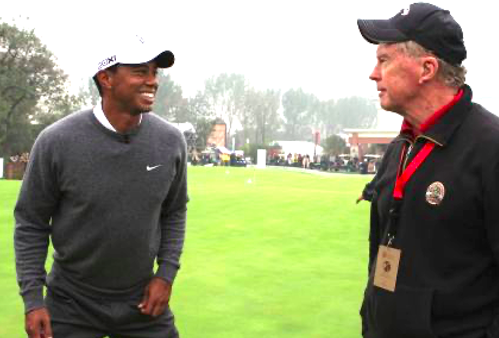
Basically, then, almost no one is willing to refer to the affable, decent and always-pleasant Rory as a choker. From a personal perspective, such a term must be scientifically justified. Having studied sports psychology at the graduate level and researched the performance and injury-risk aspects of the golf swing for over 30 years, my answer to the question of whether Rory is a choker is a resounding NO. Rory does NOT choke. In fact, he just keeps on grinding, never giving up, and that is not the sign of a choker.
While choking is a mental quality, Rory’s problem is physical. The PROBLEM is his golf swing, which is unreliable and requires great timing to pull off. Timing is not something a golfer should have to rely on under pressure. He has very slightly erratic directional control even on a driving range – some left, some right, and that characteristic gets amplified under pressure.
A report from the four rounds at the 2024 Genesis Invitational
Day 1: Rory finished 74 or +3 with four birdies, 10 pars, two bogeys, one double and one triple bogey. Literally one could, at this point say, “I rest my case”.
Let’s, however, look at all the holes where Rory had directional misses in the native area or the rough. [All information is sourced from https://www.pgatour.com/leaderboard]. The dense, spongy kikuyu grass makes Riviera Country Club’s rough rather tough to hit predictably out of. [Distance inconsistencies are an issue too, but not discussed here].
From the Play by Play results:
- Hole 4, par 3, par: Shot 1 to left rough, 34’ 8” to hole!
- Hole 6, par 3, par: Shot 1 to right rough, 28’ 8” to hole!
- Hole 11, par 5, par: Shot 1 to right rough
- Hole 12, par 4, bogey: Shot 1 to right rough, Shot 2 to left native area
- Hole 15, par 4, double bogey: Shot 1 to left rough, Shot 2 to right rough, Shot 3 to right rough
- Hole 16, triple bogey: Shot 1 to right front greenside bunker (17 yards from the pin on a 166 yd. length hole!)
- Hole 18, par 4, bogey: Shot 1 to left rough, Shot 2 to right rough
Day 2: A very clean round with two birdies, one eagle and all the rest pars. Does that mean distance DOES trump direction? While there were no bogeys or doubles, who is to say pars could not have been converted to birdies? With more fairways hit, which might have, as a result, been followed by shots closer to the pin for more birdie-opportunities?
Some wayward shots:
- Hole 1, par 5, birdie: Shot 1 to right rough then 15’ 4” to hole (might he have put it closer from the fairway?)
- Hole 3, par 4, birdie: Shot 1 to right rough, 21’ 4” to hole (how likely is a birdie from that distance?)
- Hole 9, par 4, par: Shot 1 to left native area
- Hole 10, par 4, par: Shot 1 to left rough
- Hole 13, par 4, par: Shot 1to right rough
Day 3: Five birdies, ten pars and three bogeys.
- Hole 2, par 4, birdie: Shot 1 to left rough but great approach to 2’ 3” from the hole
- Hole 8, par 4, bogey: Shot 1 to left dirt outline
- Hole 10, par 4, par: Shot 1 to right rough
- Hole 11, par 5, birdie: Shot 1 to right rough but great approach from there
- Hole 12, par 4, bogey: Shot 2 to left rough (19 yds left of pin from 185 yds.)
- Hole 13, par 4, birdie: Shot 1 to right rough but great approach from there
- Hole16, par 3, bogey: Shot 1 to left bunker, 11 yards left of flagstick from 151 yds.
Day 4: Four birdies, 11 pars and three bogeys.
- Hole 1, par 5, birdie: Shot 1 to right rough, shot 2 to left rough but only 13 yds to pin
- Hole 4, par 4, bogey: Shot 1 to left rough
- Hole 6, par 3, par: Shot 1 to left rough
- Hole 8, par 4, par: Shot 1 to left rough
- Hole 10 par 4, par: Shot 1 to right rough (short-sided given the day’s pin position)
- Hole 12, par 4, par: Shot 1 to left rough
- Hole 13, par 4, par: Shot 2 to left rough
- Hole 17, par 5, birdie: Shot 2 to left rough
Overall, a lot of left-right-left-right and the scary ability for unexpected two-way misses.
What price now being a much-vaunted long-hitter of the driver?
And, in a day when even less-talented golfers can, as Shackleford said, have good driving because of a well-fitted number 1 wood, equipment can no longer be an excuse.
The swing’s true problems which are subject to timing issues, can best be seen via an ANATO-MECHANICAL ANALYSIS.
This is a very unique analysis that you will not see anywhere else.
Moreover, below is a big-picture-only one, in the interest of keeping the explanation simple.
A more detailed analysis including a joint-by-joint analysis for elite golfers is also available, see: https://yourgolfguru.com/important-new-announcement/ ).
One of the first steps is to understand what the golfer himself is trying to achieve.
In this video (https://www.youtube.com/watch?v=wt9P-7CZqPg ), Rory says that his typical shot-pattern is a draw and to get one he tries to relax his right shoulder to the club can drop below the (backswing) plane. For a cut he tries to hold onto the clubface angle.
Any time a golfer requires downswing thoughts, it means he is not in the place he should be at the top of the backswing. And there is literally no time to pull off downswing thoughts consistently in the limited time (1/3rd second or less) that the entire downswing lasts. So, for instance, he has an unnecessarily steep takeaway (blue lines in picture below) and backswing and then wants to drop below it (red lines)? Why not go back on plane instead? It is very easy to do that if the backswing is a far simpler movement.
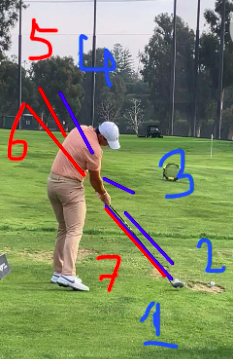
And then, very close to impact to try to hold the clubface angle for a cut? From the picture below, he is most likely trying to ‘hold off’ with his right hand. That is extremely scary as the right hand force, according to a 2014 study by Langlais and Broker (Grip pressure distributions and associated variability in golf: a two-club comparison) is always much lower than the left, and in the last 100ms prior to impact drops down steeply to practically zero. In other words, as right hand grip force is reducing, the golfer is trying to get into an intentional position with it?
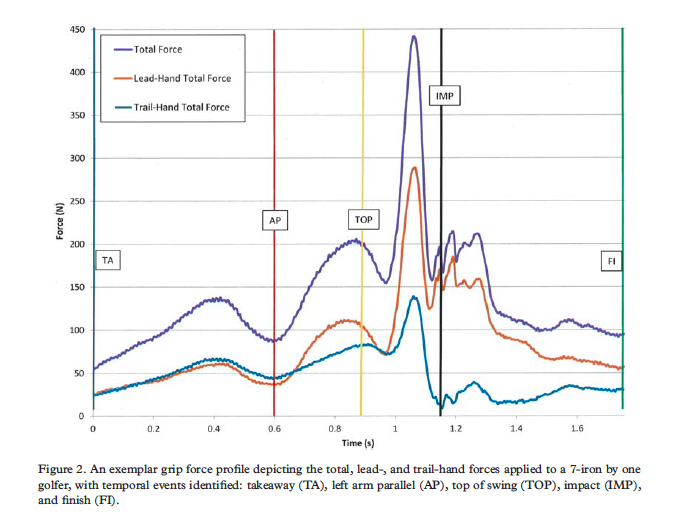
To ‘hold the clubface’ requires many body positions all being correct. See the subtle differences in one picture of impact from 2022 (left) and one from 2024 below on the right. Note, especially, the distance of the right arm from the body, the the roll-over (pronation) of the trail/right elbow and the position of the wrist/hand: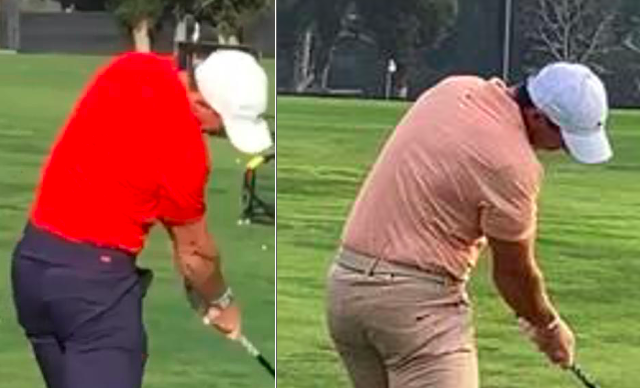
There are two main reasons Rory does not have adequate clubface control to always hit straight shots. And neither has ever been conceived of before.
- Four trail side (i.e. right, in Rory’s case) body parts must be behind/closed to their lead side counterparts at impact – the thigh, elbow, shoulder and ear. If any of them are closer to the target line than the same body part of the lead side, the club will be moved inside AND ALSO FACE LEFT relative to the target line and the pull-group of shots can result. As only highly skilled golfers can rotate the abovementioned body parts so far open, it is no wonder that excessively left-moving shots are especially common among better golfers.
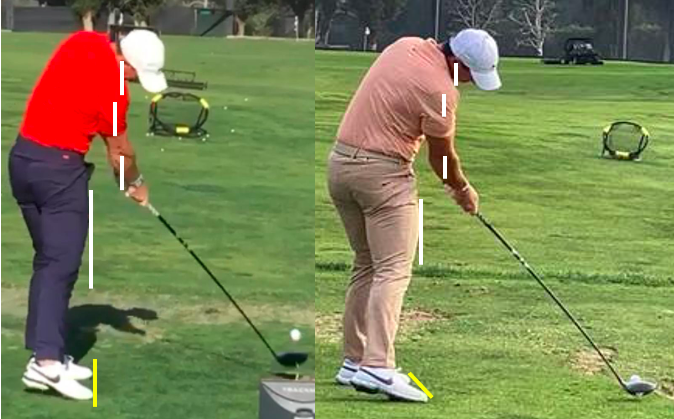
Other top golfers with some of the four trail side body parts ‘open’ to their lead side counterparts
Tiger’s now-famous shank during the Genesis Invitational 2024
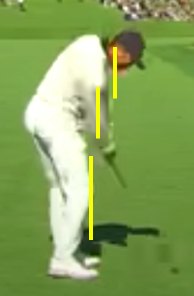
Bryson DeChambeau on a badly pushed out shot (left) and a good shot (right) during a recent LIV Golf event in Las Vegas
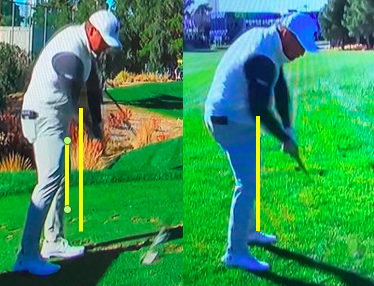
- The trail elbow should not just be behind the lead one at impact, but must not be in front of the body at all (see below). The reason is that a trail elbow ‘supported’ by the body (i.e. close to/touching) is able to fold (flex) correctly in the backswing and straighten (extend) correctly in the downswing without allowing unexpected trail forearm roll over (pronation). See Bryson’s elbow in picture on the right above, and all four important body parts in the picture below.
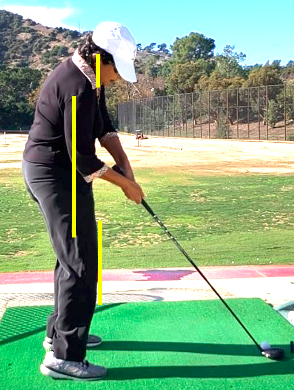
While the main reasons for directional mishits, especially the leftward moving ones better players make are mentioned above, there are other reasons for directional issues, but all of them can be corrected through the use of a suitable set-up and backswing, resulting, very importantly, in a NON-COMPENSATING DOWNSWING.
Overall for a golf swing to have directional and distance consistency, it should have much less body motion. [See the huge shoulder motion Rory has from set-up to the top to impact in the picture below. The torso – between the arms and the legs – is a slow moving, poorly-innervated part of the body, not capable of quick, subtle movements].

Such a swing must be based on a strong understanding of which joints need to be positioned where during the set-up and backswing to create a completely compensation-free, highly consistent downswing for far better performance and scoring.
In conclusion, Rory is no choker and he is very diligent about doing what he has been taught to do over the years. [Therein lies the problem!]
No one has analyzed his golf swing from an ANATO-MECHANICAL PERSPECTIVE. And Rory is quite aware of his issues although probably not of useful solutions [Indicated by his saying, “I feel like my game’s close”. How can such a seasoned golfer still be unsure and merely ‘close’ after all these years of competitive golf at the highest level?]
Rory’s overall analysis of his week at the 2024 Genesis Invitational can be summed up by his post-round-interview statement, “If you’re just slightly off, your weakness is going to be magnified this week”.


